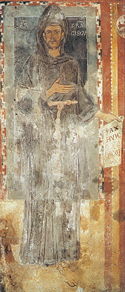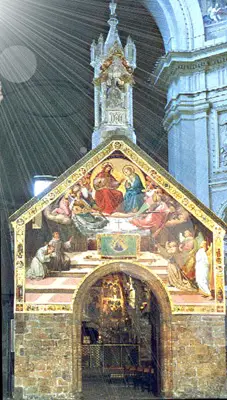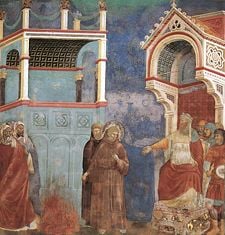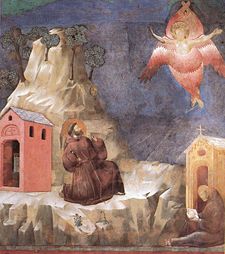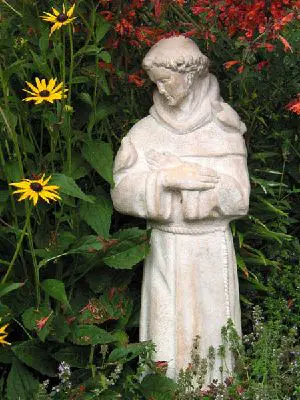Francis of Assisi
- "Saint Francis of Assisi", "St. Francis of Assisi" and "St Francis of Assisi" all redirect here. For the opera by Olivier Messiaen see Saint-François d'Assise.
| Saint Francis of Assisi | |
|---|---|
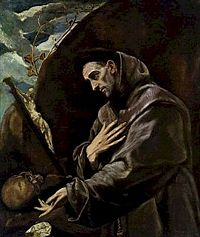
| |
| Confessor | |
| Born | 1182, Assisi, Italy |
| Died | 4 October, 1226, Porziuncola, Assisi, Italy |
| Venerated in | Roman Catholicism |
| Canonized | 16 July, 1228, place |
| Major shrine | Basilica of St. Francis of Assisi |
| Feast | 4 October |
| Attributes | Dove, Stigmata |
| Patronage | animals, merchants, Italy, Catholic Action, the environment, Cub Scouts |
Saint Francis of Assisi (1182 – 4 October 1226) founded the Franciscan Order or "Friars Minor". He is the patron saint of animals, merchants, Italy, Catholic action, and the environment.
Boyhood and early manhood
Born Giovanni di Bernardone, commonly known as Francesco (meaning in Italian, "Little Frenchman". This pet name having been chosen by his father after the death of Giovanni's mother - she having been of French origin). He was either born in 1181 or 1182. His father, Pietro, was a wealthy cloth merchant. Of his mother, Pica, little is known. Francis was one of several children.
Rebellious toward his father's business and pursuit of wealth, Francis would spend most of his youth lost in books (ironically, his father's wealth did afford his son an excellent education, and he became fluent in reading several languages including Latin). He was also known for drinking and enjoying the company of his many friends, who were usually the sons of nobles. His displays of disillusionment toward the world that surrounded him became evident fairly early, one of which is shown in the story of the beggar. In this account, he found himself out having fun with his friends one day when a beggar came along and asked for alms. While his friends ignored the beggar's cries, Francis gave the man everything he had in his pockets. His friends quickly chided and mocked him for his stupidity, and when he got home, his father scolded him in a rage.
In 1201 he joined a military expedition against Perugia, was taken prisoner at Collestrana, and spent a year as a captive. It is probable that his conversion to more serious thoughts was a gradual process relating to this experience.
After his return to Assisi in 1203, Francis recommenced his carefree life. But in 1204 a serious illness started a spiritual crisis. In 1205 Francis leaves for Puglia to enlist in the army of Gualtiero di Brienne. But on his way, in Spoleto, a strange vision makes him return to Assisi, deepening his spiritual crisis.
It is said that when he began to avoid the sports and the feasts of his former companions, and they asked him laughingly if he was thinking of marrying, he answered "Yes, a fairer bride than any of you have ever seen" - meaning his "lady poverty", as he afterward used to say.
He spent much time in lonely places, asking God for enlightenment. By degrees he took to nursing lepers, the most repulsive victims in the lazar houses near Assisi.
After a pilgrimage to Rome, where he begged at the church doors for the poor, he had a mystical experience in the Church of St. Damian just outside of Assisi, in which the Icon of Christ Crucified came alive and said to him 3 times, "Francis, Francis, go and repair My house which, as you can see, is falling into ruins." He thought this to mean the very ruined church in which he was presently praying, and so sold his horse together with some cloth from his father's store, to assist the priest there for this purpose.
Pietro, highly indignant, attempted to bring him to his senses, first with threats and then with corporal chastisement. After a final interview in the presence of the bishop, Francis renounced his father and his patrimony, laying aside even the garments he had received from him. For the next few months he lived as a beggar in the region of Assisi.
Returning to the town where he spent two years this time, he restored several ruined churches, among them the Porziuncola, little chapel of St Mary of the Angels, just outside the town, which later became his favorite abode.
The Founding of the Order of Friars Minor
At the end of this period (according to Jordanus, on February 24, 1209), a sermon which he heard on the Gospel of Matthew 10:9, where Christ tells his followers that they should go forth and proclaim that the Kingdom of Heaven is upon them, and that they should take no money with them, that they should take no walking stick for the road, and that they should wear no shoes — made such an impression on him that he decided to devote himself wholly to a life of apostolic poverty.
Clad in a rough garment, barefoot, and, after the Evangelical precept, without staff or scrip, he began to preach repentance. He was soon joined by his first follower, a prominent fellow townsman, the jurist Bernardo di Quintavalle, who contributed all that he had to the work. Many other companions joined Francis, and reached the number of eleven within a year. In his humility Francis chose never to be ordained a priest, and the community lived as "fratres minores", in Latin, "lesser brothers". The Franciscans are sometimes called Friars Minor, a term derived from "fratres", in Latin, "brothers".
The brothers lived a simple life in the deserted lazar house of Rivo Torto near Assisi; but they spent much of their time wandering through the mountainous districts of Umbria, always cheerful and full of songs, yet making a deep impression on their hearers by their earnest exhortations.
In 1209 Francis led his first 11 followers to Rome and asked the Pope's permission to found a new religious order and succeeded in gaining the approval of Pope Innocent III. At first his attempt to speak with the Pope was refused; but the following night, Innocent III saw in a dream the church was crumbling apart and a poor man appearing to hold it up. The next morning, recalling the poor man he had refused the day before, he recognized him as the man he saw in his dream, and decided to change his verdict the following day.
Later life
From then on his new order grew quickly with new vocations. When hearing Francis preaching in the church of San Rufino in Assisi in 1209, Clare of Assisi became deeply touched by his message and she realized her calling. Her brother Rufino also joined the new order.
On Palm Sunday, 28 March 1211 Francis received Clare at the Porziuncola and hereby established the Order of Poor Dames, later called Poor Clares.
In the same year, Francis left for Jerusalem, but he was shipwrecked by a storm on the Dalmatian coast, forcing him to return to Italy.
On the 8 May 1213 he received the mountain of Verna as a gift from the count Orlando di Chiusi. This mountain would become one of his favourite retreats for prayer. In the same year, Francis sailed for Morocco, but this time an illness forced him to break off his journey in Spain. Back in Assisi, several nobleman (among them Tommaso da Celano, who would later write the biography of St. Francis) and some well-educated men joined his order.
In 1215 Francis went again to Rome for the Fourth Lateran Council. During this time, he probably met Dominic de Guzman.
In 1216 Francis received from the new pope Honorius III the confirmation of the indulgence of the Porziuncola, now better known as the Pardon of Assisi : a complete remission of their sins for all those who prayed in the Porziuncola.
In 1217 the growing congregation of friars was divided in provinces and groups were sent to France, Germany, Hungary, Spain and to the East.
In 1219 Francis left, together with a few companions, for Egypt. Received by the sultan Melek-el-Kamel, Francis challenged the muslim priests to a test of true religion by fire. But they retreated. When Francis proposed to enter the fire first and, if he left the fire unharmed, the sultan would have to recognize Christ as the true God, the sultan allowed him to preach to his subjects. On 5 November 1219 Francis helped the crusaders to capture Damietta. At Saint Jean d'Acre, the capital of what remained of the Kingdom of Jerusalem, he rejoined the brothers Elia and Pietro Cattini. Francis then most probably visited the holy places in Palestine in 1220.
When receiving a report of the martyrdom of five brothers in Morocco, he returned to Italy via Venice. Cardinal Ugolino di Conti was then nominated by the pope as the protector of the order.
When problems arose in the order, a detailed rule became necessary. On 29 September 1220 Francis handed over the governance of the order to brother Pietro Cattini at the Porziuncola. Soon afterwards however, brother Cattini died on 10 March 1221. He was buried in the Porziuncola. But when he started in his death to work numerous miracles, people started to flock to the Porziuncola, disturbing the daily life of the franciscans. Francis then begged him to stop the miracles and obey in death as he had obeyed him during his life. From that moment the miracles ceased.
Brother Pietro was succeeded by brother Elia as vicar of Francis.
During 1221 and 1222 Francis crossed Italy, first as far south as Catania in Sicily and afterwards as far north as Bologna.
On 29 November 1223 the final rule of the order (in 12 chapeters) was approved by pope Honorius III.
While he was praying on the mountain of Verna, together with his close friend Thomas, Francis received the Stigmata on 17 September 1223. Suddenly he saw a vision of an angel on a cross. This angel bore holes into St. Francis's feet, hands, and chest. This is the first account of Stigmata in history. However, no one knew about this occurrence until after his death, when Thomas told a crowd of Franciscans that he had witnessed this account.
Suffering from these Stigmata and from an eye disease, he had been receiving care in several cities (Siena, Cortona, Nocera) to no avail. In the end he was brought back to the Porziuncola. He was brought to the transito, the hut for infirm friars, next to the Porziuncola. Here, in the place where it all began, feeling the end approaching, he spent the last days of his life dictating his spiritual testament. He died on the evening of 3 October 1226.
On 16 July 1228 he was pronounced a saint by the next pope Gregory IX, the former cardinal Ugolino di Conti, friend and protector of St. Francis. The next day, the pope laid the foundation stone for the Basilica of Saint Francis in Assisi.
St. Francis, Nature, and the Environment
Many of the stories that surround the life of St. Francis deal with his love for animals.
Perhaps the most famous incident that illustrates the Saint’s humility towards nature is recounted in the Vigina (The Little Flowers), a collection of legends and folk-lore that sprang up after the saint’s death. It is said that one day while Francis was traveling with some companions they happened upon a place in the road where birds filled the trees on either side. Francis told his companions to “wait for me while I go a preach to my sisters the birds.” The birds surrounded him, drawn by the power of his voice, and not one of them flew away. Francis spoke to them:
“My sister birds, you owe much to God, and you must always and in everyplace give praise to Him; for He has given you freedom to wing through the sky and He has clothed you…you neither sow nor reap, and God feeds you and gives you rivers and fountains for your thirst, and mountains and valleys for shelter, and tall trees for your nests. And although you neither know how to spin or weave, God dresses you and your children, for the Creator loves you greatly and He blesses you abundantly. Therefore…always seek to praise God.”
Another legend from the Fioretti tells us that in the city of Gubbio, where Francis lived for some time, there was a wolf “terrifying and ferocious, who devoured men as well as animals.” Francis had compassion upon the townsfolk, and went up into the hills to find the wolf. Soon fear of the animal had caused all his companions to flee, but the saint pressed on and when he found the wolf he made the sign of the cross and commanded the wolf to come to him and hurt no one. Miraculously the wolf closed his jaws and lay down at the feet of St. Francis. “Brother Wolf, you do much harm in these parts and you have done great evil…” said Francis. “All these people accuse you and curse you…But brother wolf, I would like to make peace between you and the people.”
Then Francis led the wolf into the town, and surrounded by startled citizens he made a pact between them and the wolf. Because the wolf had “done evil out of hunger” the townsfolk were to feed the wolf regularly, and in return, the wolf would no longer prey upon them or their flocks. In this manner Gubbio was freed from the menace of the predator. Francis, ever the lover of animals, even makes a pact on behalf of the town dogs, that they will not bother the wolf again.
These legends exemplify the Franciscan mode of charity and poverty as well as the saint's love of the natural world.
Part of his appreciation of the environment is expressed in his Canticle of the Sun, a poem written in Umbrian Italian in perhaps 1224 which expresses a love and appreciation of Brother Sun, Sister Moon, Mother Earth, Brother Fire, etc. and all of God's creations personified in their fundamental forms.
However, the academic establishment agrees that St. Francis actually had a rather conventional attitude towards his worldly environment. He did believe that the external world was inherently good as a sign and revelation of God's providence and goodness, its purpose being to inspire our respect and love, but this was not an unusual philosophy in the thirteenth century. His belief in the universal ability and duty of all creatures to praise God is remarkable.
Main sources for the life of St. Francis
- Friar Elias, Epistola Encyclica de Transitu Sancti Francisci, 1226.
- Pope Gregory IX, Bulla "Mira circa nos" for the canonisation of St. Francis, 19 July 1228.
- Friar Tommaso da Celano: Vita Prima Sancti Francisci, 1228; Vita Secunda Sancti Francisci, 1246–1247; Tractatus de Miraculis Sancti Francisci, 1252–1253.
- Friar Julian of Speyer, Vita Sancti Francisci, 1232–1239.
- St. Bonaventure of Bagnoregio, Legenda Maior Sancti Francisci, 1260–1263.
- Ugolino da Montegiorgio, Actus Beati Francisci et sociorum eius, 1327–1342.
- Fioretti di San Francesco, the "Little Flowers of St. Francis", end of the 14th century: an anonymous Italian version of the Actus; the most popular of the sources, but very late and therefore not the best authority by any means.
For an exhaustive list of sources, see [1].
Main writings by St. Francis
- Canticum Fratris Solis, the Canticle to Brother Sun.
- Prayer before the Crucifix, 1205 (extant in the original Umbrian dialect as well as in a contemporary Latin translation).
- Regula non bullata, the Earlier Rule, 1221.
- Regula bullata, the Later Rule, 1223.
- Testament, 1226.
- Admonitions.
For a complete list, see [2].
See also
| Saints Portal |
- Brother Sun, Sister Moon (1972) by Franco Zeffirelli
- Prayer of Saint Francis, Prayer once attributed to St. Francis of Assisi, although in fact it first appeared several centuries after his death.
- Clare of Assisi
- Saint Juniper, one of Francis' original followers.
- Saint David
- University of Saint Francis (Illinois), a school founded in the tradition of St. Francis of Assisi.
- List of people on stamps of Ireland
- Saint Margaret of Cortona
- The Flowers of St. Francis (1950), a film by Roberto Rossellini
External links
- The Franciscan Archive
- Franciscan Cyberspot: Sources for the Life of St. Francis
- Article on St Francis at Catholic Online
- detailed Article on Francis of Assisi from the Catholic Encyclopedia
Credits
New World Encyclopedia writers and editors rewrote and completed the Wikipedia article in accordance with New World Encyclopedia standards. This article abides by terms of the Creative Commons CC-by-sa 3.0 License (CC-by-sa), which may be used and disseminated with proper attribution. Credit is due under the terms of this license that can reference both the New World Encyclopedia contributors and the selfless volunteer contributors of the Wikimedia Foundation. To cite this article click here for a list of acceptable citing formats.The history of earlier contributions by wikipedians is accessible to researchers here:
The history of this article since it was imported to New World Encyclopedia:
Note: Some restrictions may apply to use of individual images which are separately licensed.

